Instead of walking and sightseeing around Cannes, this time around I opted for something completely different and that was a boat trip to the Lérins Islands or, to be more precise, to the biggest of the four and one of the two inhabited, which was Sainte-Marguerite Island (Île Sainte-Marguerite). The trip is not formal and organised, but several times a day there are boat connections between Cannes and the islands, and then the visitor practically visits on his own what he is interested in.
The islands were inhabited during the Roman age, but on the second largest, the isle of Saint Honorat (Île Saint-Honorat), a monastic community was founded already in the 5th century. The isle of Saint Marguerite (Île Sainte-Marguerite) had a somewhat different history and although both islands are interesting for sightseeing, I opted for the latter.
Both islands are predominantly covered by vegetation, but what makes Île Sainte-Marguerite famous is its fortress prison called Fort Royal. This is the place where in the 17th century the so-called Man in the Iron Mask was imprisoned. This specific building can be seen clearly as the boat approaches the docking pier.
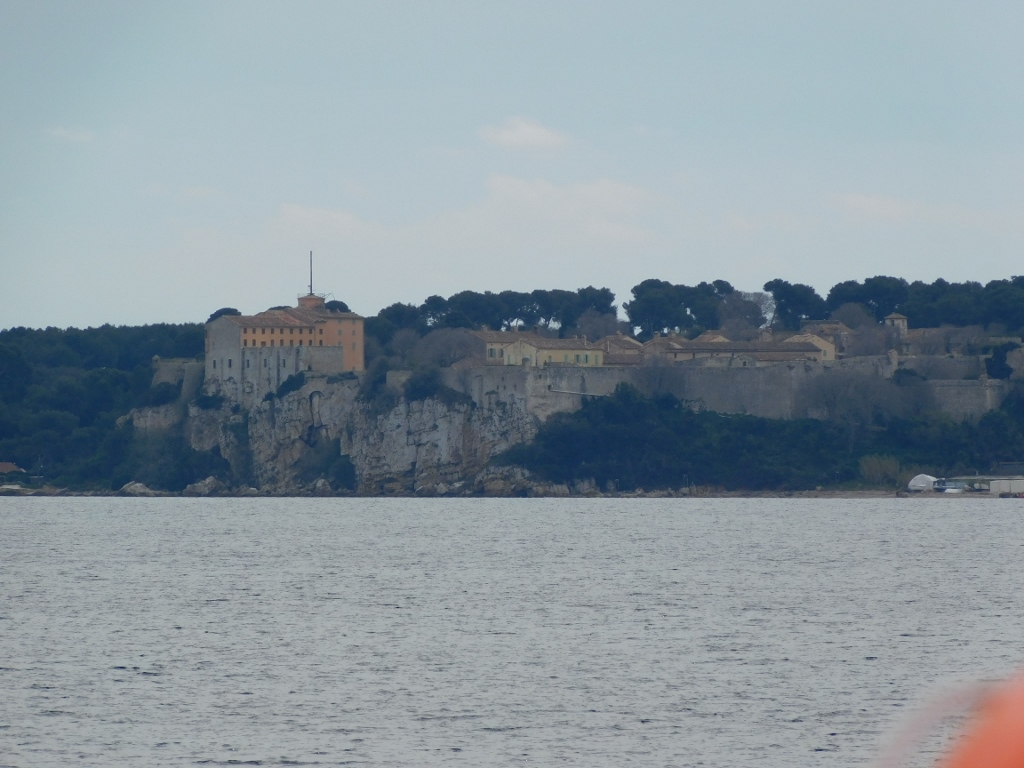 Fortress on Sainte-Marguerite Island; the prison is adjacent to the large building with orange walls
Fortress on Sainte-Marguerite Island; the prison is adjacent to the large building with orange walls
As the boat approached the pier, I could take photos both of some parts of the island and of a part of the coast where Cannes could be discerned.
 The shore and Cannes are to the left, while Sainte-Marguerite Island is to the right
The shore and Cannes are to the left, while Sainte-Marguerite Island is to the right
Sainte-Marguerite Island is around 3.2 km long and around 900 m wide. The construction of the fortress started at the beginning of the 17th century. By the end of that same century, Fort Royal became a barracks, as well as a state prison. In addition, during the 18th century, a small village developed on the island and it still exists.
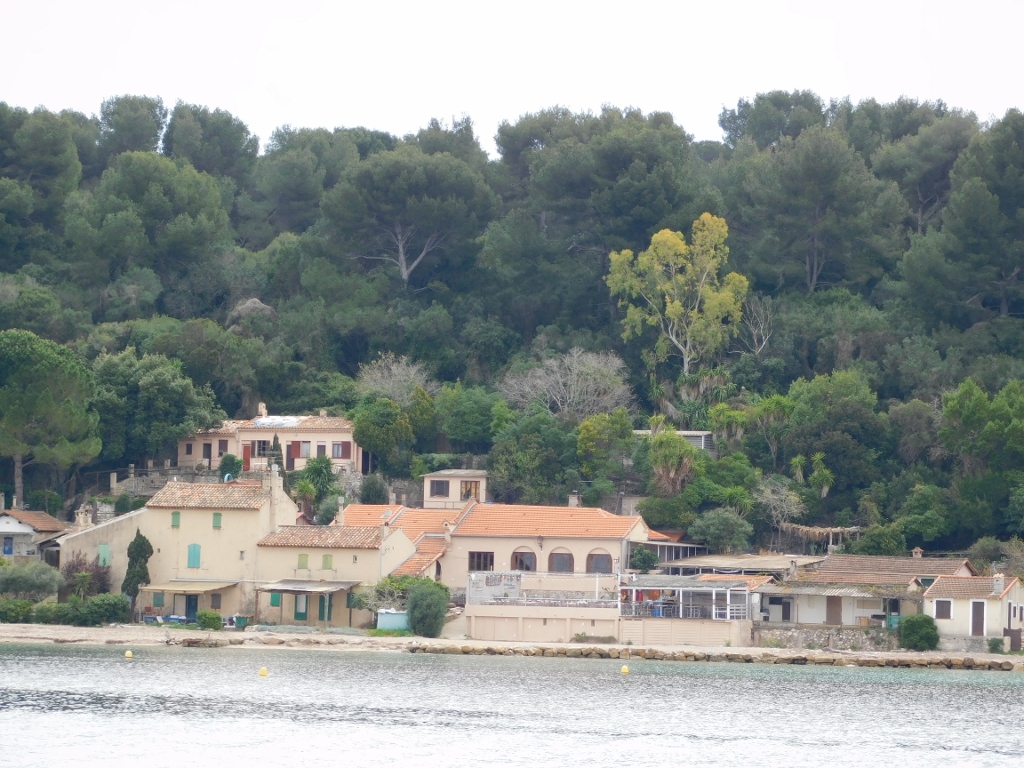 Village of Sainte-Marguerite
Village of Sainte-Marguerite
The village consists of some twenty houses and it is mostly inhabited by fishermen, but there is also a small boatyard. I was primarily interested to get to the fortress with a museum that incorporates some specific prison cells. My plan was simply to walk around the island afterwards, but I had to bear in mind the time when I was to return to the pier, since the boat schedule was fixed.
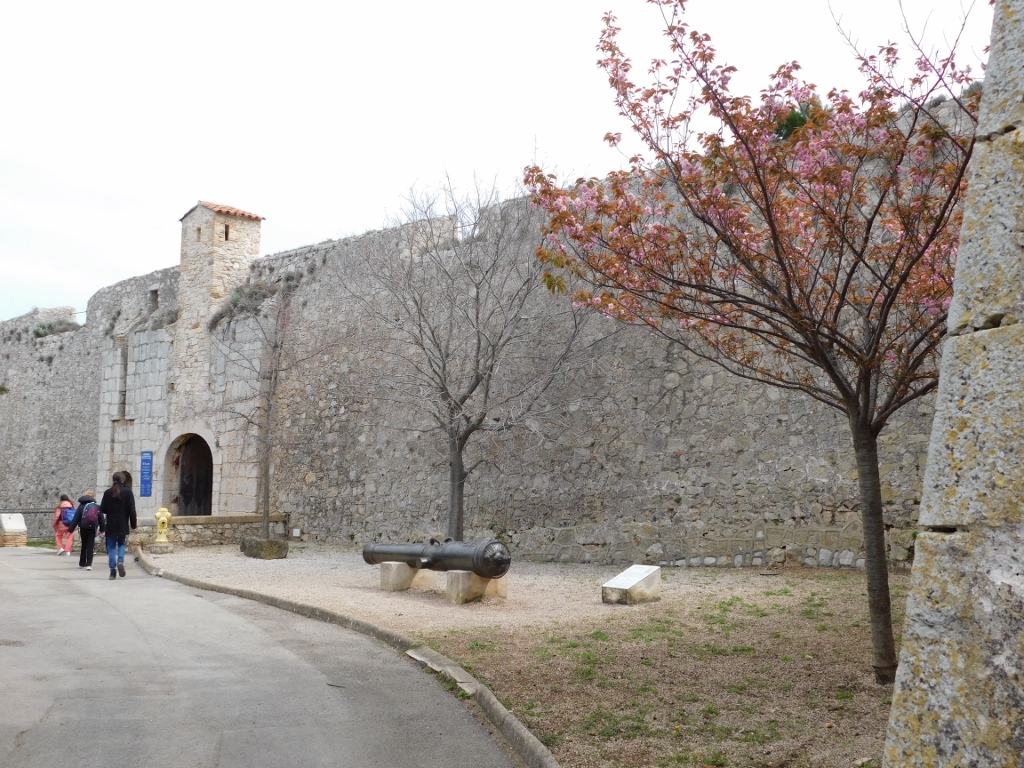 Entrance into the fortress
Entrance into the fortress
Before formally entering the fortress, from an open area in front of it I took photos of the shore, Cannes and the surroundings.
 View at the shore, Cannes and the surroundings
View at the shore, Cannes and the surroundings
And then I entered Fort Royal. Taking into account that there used to be a military barracks here, there are different buildings with simple architecture that nowadays have an entirely civilian function.
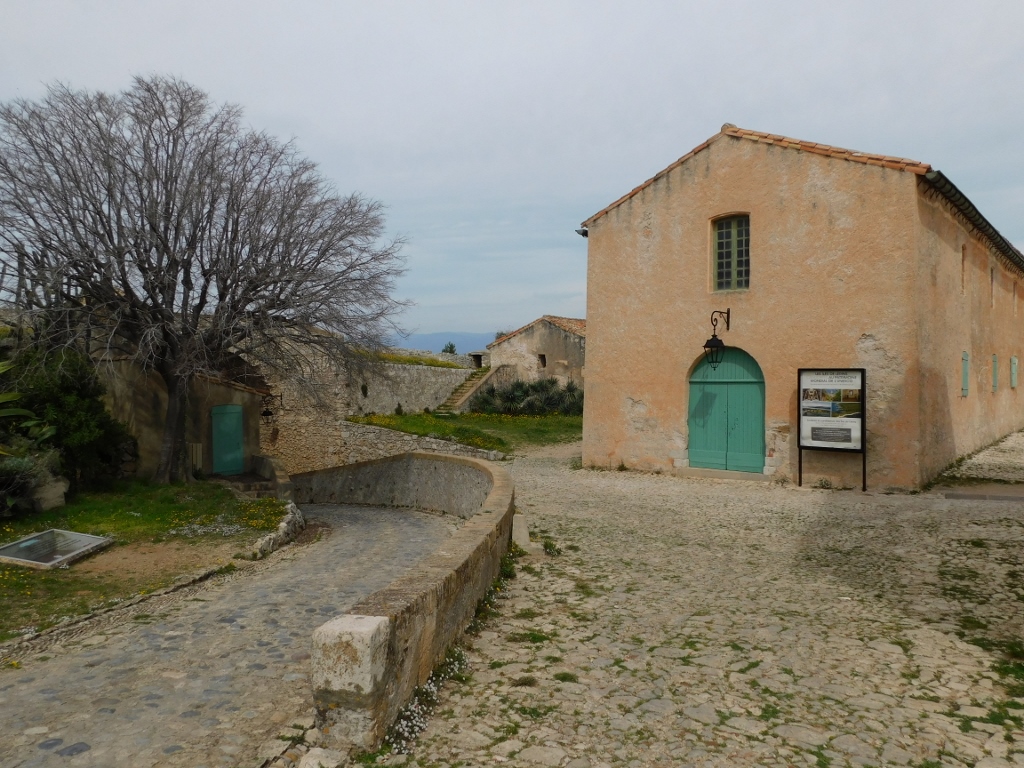 Fort Royal, a detail
Fort Royal, a detail
The most important and the biggest building within the fortress is a museum today and it exhibits archaeological artefacts, artistic pieces, as well as historical items.
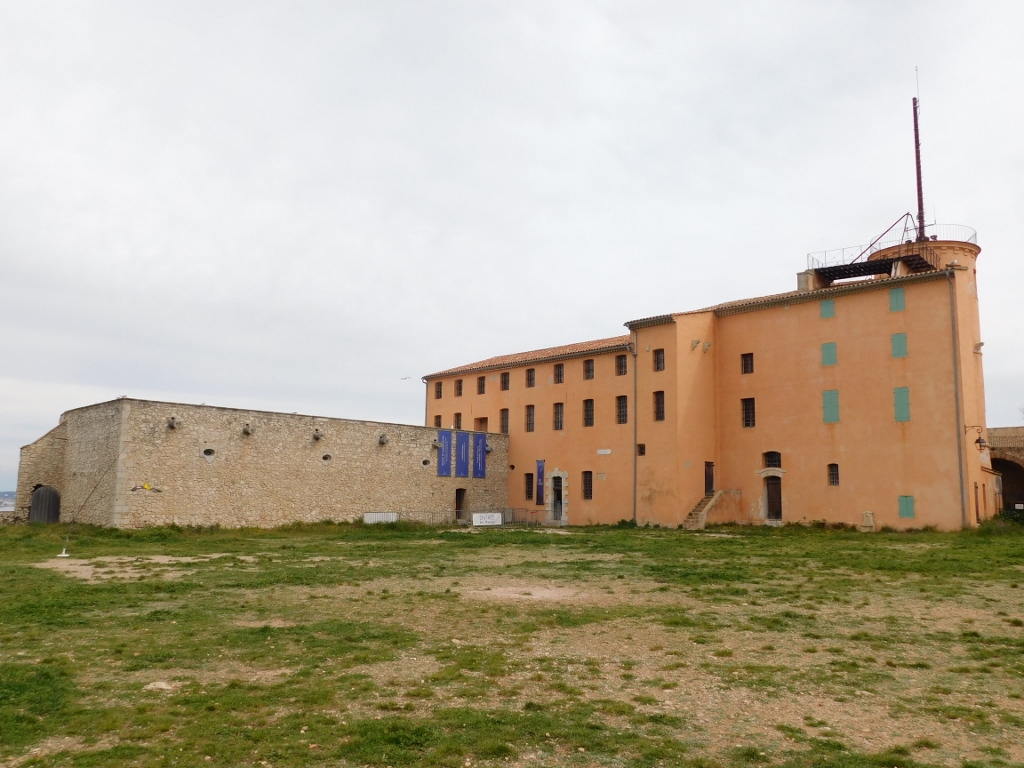 Iron Mask and Fort Royal Museum
Iron Mask and Fort Royal Museum
I walked around the entire museum which is not too big despite the size of the building. The museum includes a purpose-built prison with only a couple of cells for “selected” prisoners. Of course, the most interesting was to go to the cell where the Man in the Iron Mask was held. Still, let me mention that this was not the only prisoner in Fort Royal. On the contrary, over a couple of centuries numerous people were imprisoned here and some of them are well-known on different grounds. This continued until the 20th century when the prison was closed. By the way, in addition to Protestants who were during the 17th and the 18th centuries put in prisons, including this one, for “religious crimes,” from 1840 this was also the place where rebels arrested during the colonisation of Algeria were incarcerated.
As for the mysterious prisoner known as the Man with the Iron Mask, according to what I have read, a prisoner of state unknown to history was arrested in 1669 and registered under a pseudonym, only to remain incarcerated until 1703 when he died. In other words, he spent 34 years in prison. It needs to be said that he did not spend all this time in a single prison, but rather he was moved around and eventually died in Bastille, while during the period 1687-1698 he was kept here at the prison on Sainte-Marguerite Island. Also, this was all taking place during the reign of Louis XIV (1643-1715).
Despite different researches, it remains unknown who this actually was, although there have been all sorts of theories, as well as literary works on the subject. The most famous literary work dealing with the topic is certainly “Le Vicomte de Bragelonne,” a novel by Alexandre Dumas where the author gives his version which was that this was a twin brother of Louis XIV.
It is also interesting that the prisoner whose identity for some reason had to remain unknown most likely only used some kind of a head cover made of black velvet and according to the official documents even this was used only when the prisoner was moved from one prison to the next. However, it was Voltaire himself who introduced the concept of an iron mask into the whole mystery, which was then taken over by history.
Be as it may, within the museum I got to the entrance into the cell in which the Man with the Iron Mask spent 11 years. You can see right away the thickness of the walls of the cell that goes from 1 to 1.5 m. It is also important that there used to be three doors.
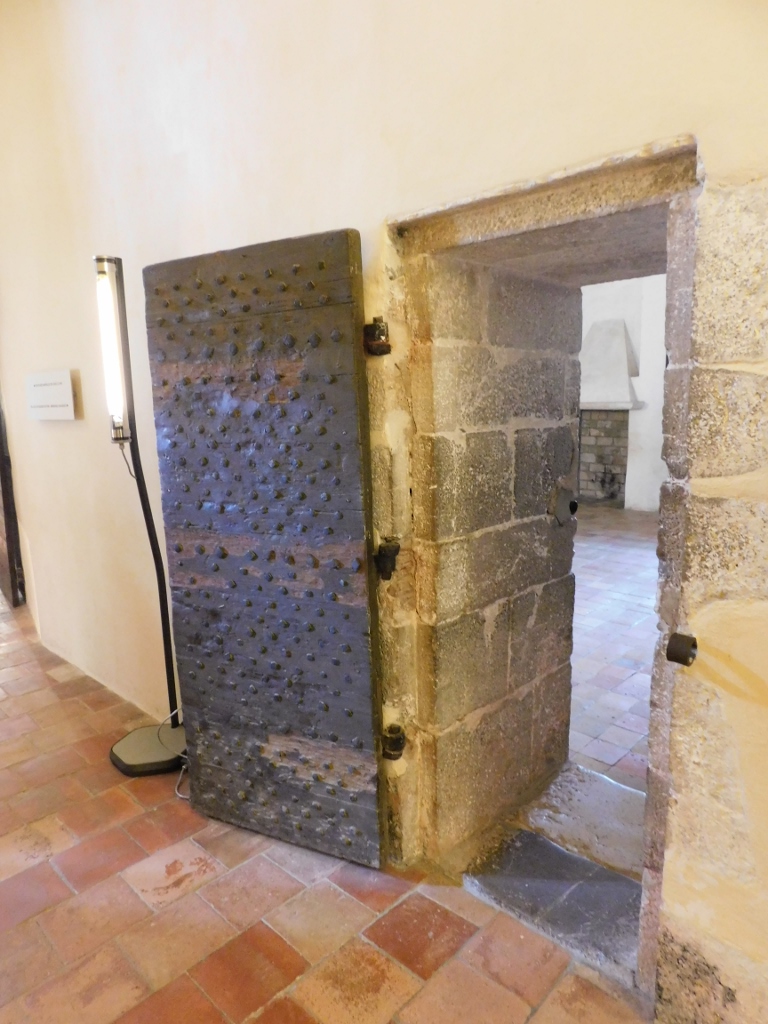 Entrance into the cell of the Man with the Iron Mask
Entrance into the cell of the Man with the Iron Mask
And then I entered the cell.
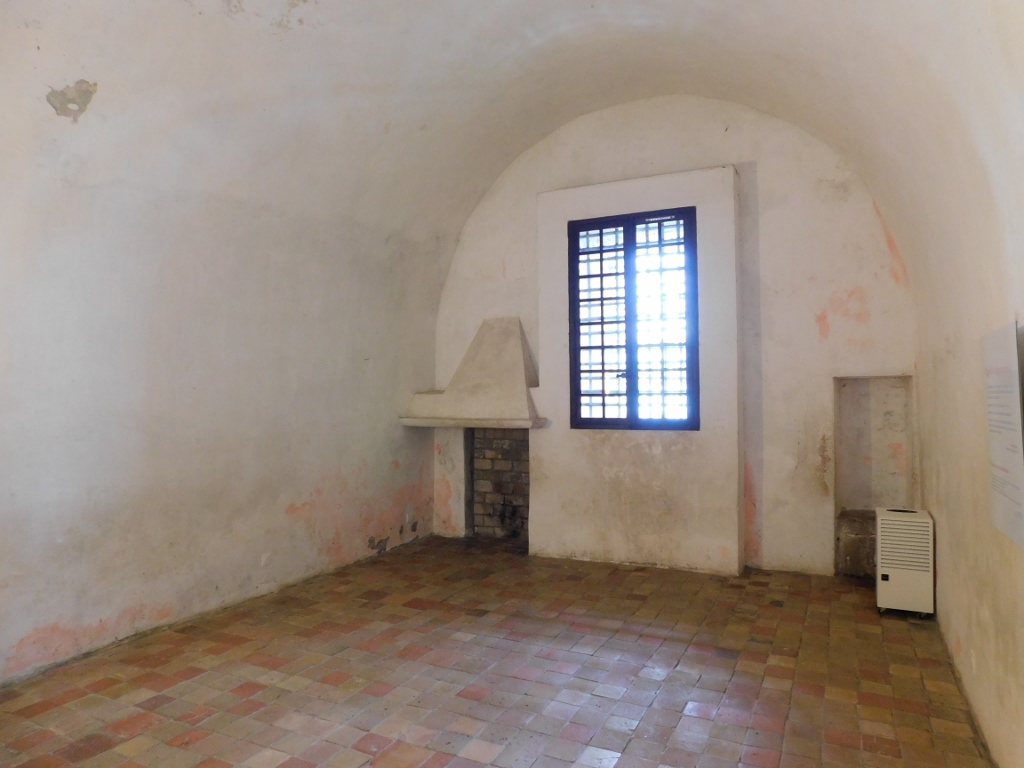 Cell of the Man with the Iron Mask
Cell of the Man with the Iron Mask
This is a rather spacious room of some 30 sq. m with a high vault and in the wall opposite the entrance door you can see a hearth with chimney (left), a window and a latrine (right, behind the temperature/humidity device). I found the window particularly interesting.
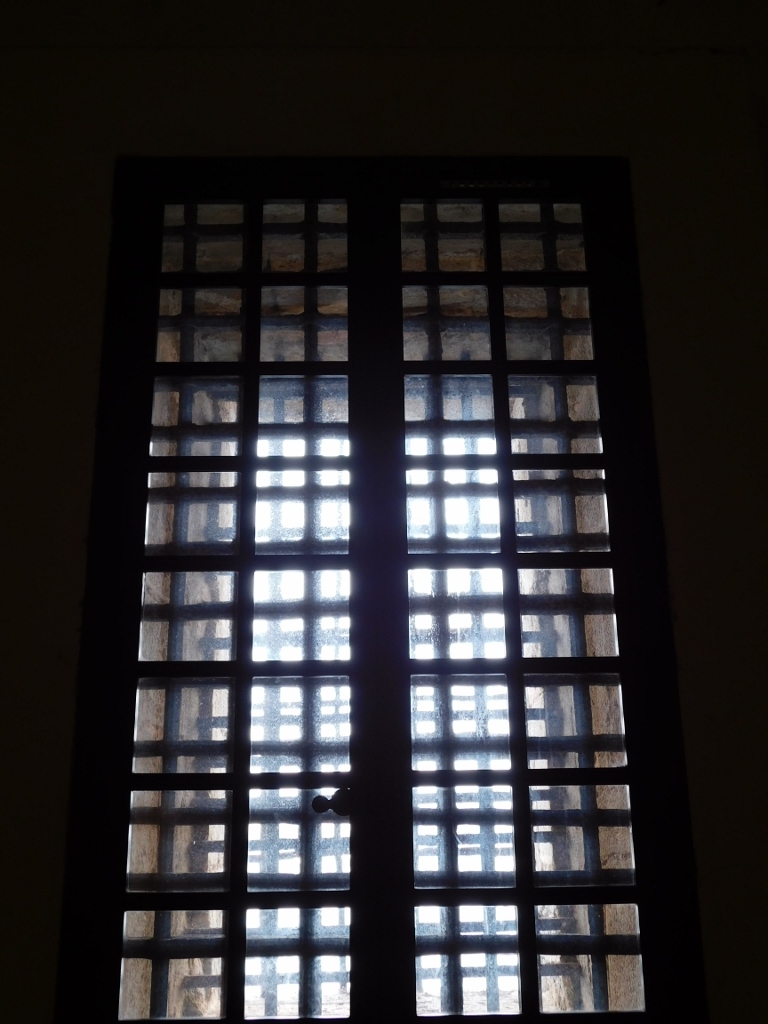 Window in the cell of the Man with the Iron Mask
Window in the cell of the Man with the Iron Mask
Namely, within the thickness of the wall there are three metal grids made on purpose in such a way that their openings are in disarray, which practically prevented anything from being thrown out of the window. On the other hand, I’m not sure something like that would make any sense, since the cell was built on top of a cliff and the window is directly 22 m above the sea surface.
However, the most interesting aspect is that everything in fact shows that the prisoner who was here was not at all a typical prisoner who lived under catastrophically bad conditions. This one had a bed, fine linen that was changed twice a week, clothes, etc., and he also played an instrument and was treated with respect. The proof of this special status lies in the frescoes on the wall where the entrance into the cell is.
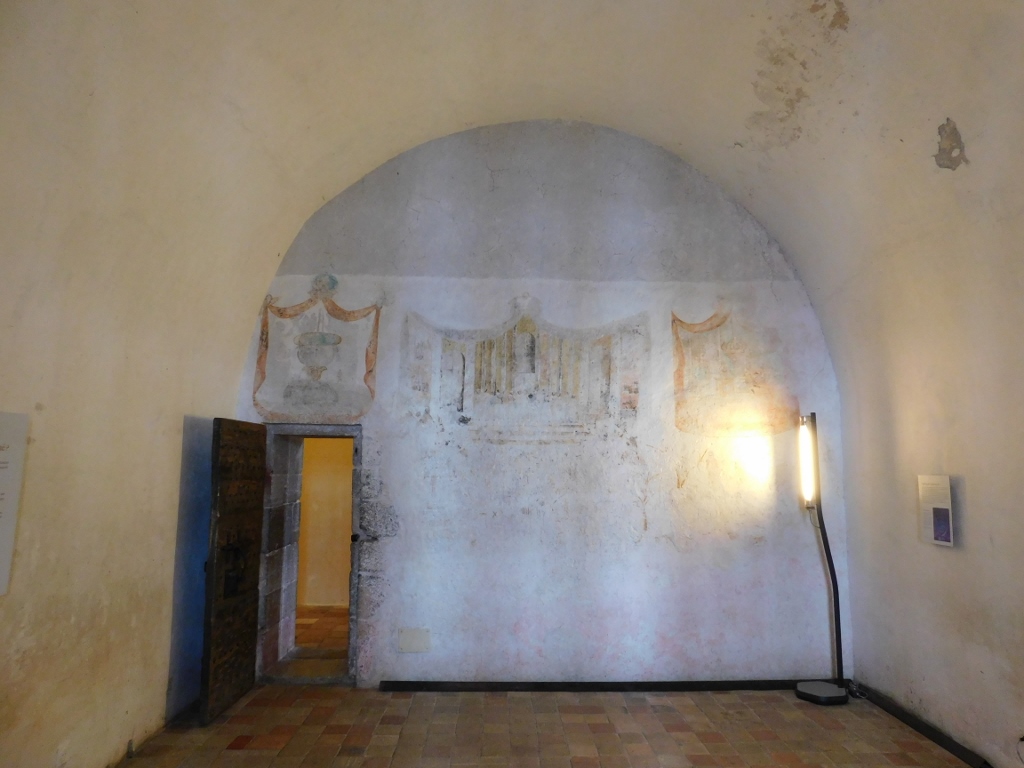 Cell of the Man with the Iron Mask
Cell of the Man with the Iron Mask
This is the only decoration in the entire prison and it consists of three segments. It is presumed that the central image was inspired by the Bible. The fresco was restored in 1990, it was originally made by somebody who was not a professional painter and could date back to the time when the Man in the Iron Mask was here.
After this, I visited the rest of the museum and then I got out and walked some more around Fort Royal.
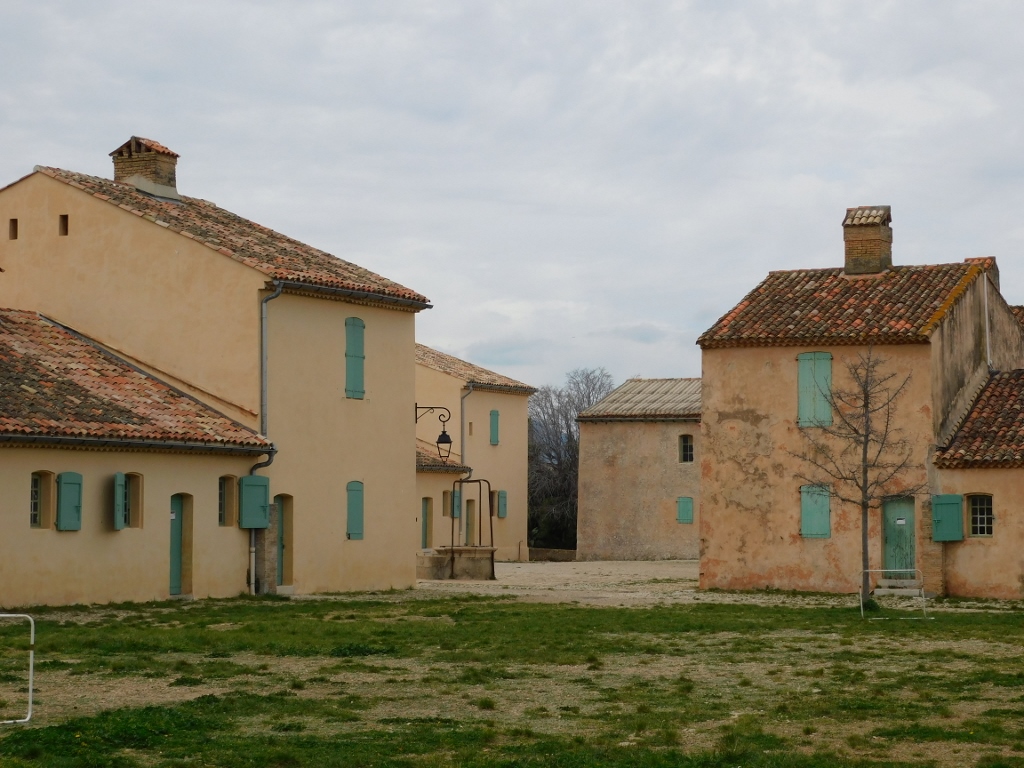 Fort Royal, a detail
Fort Royal, a detail
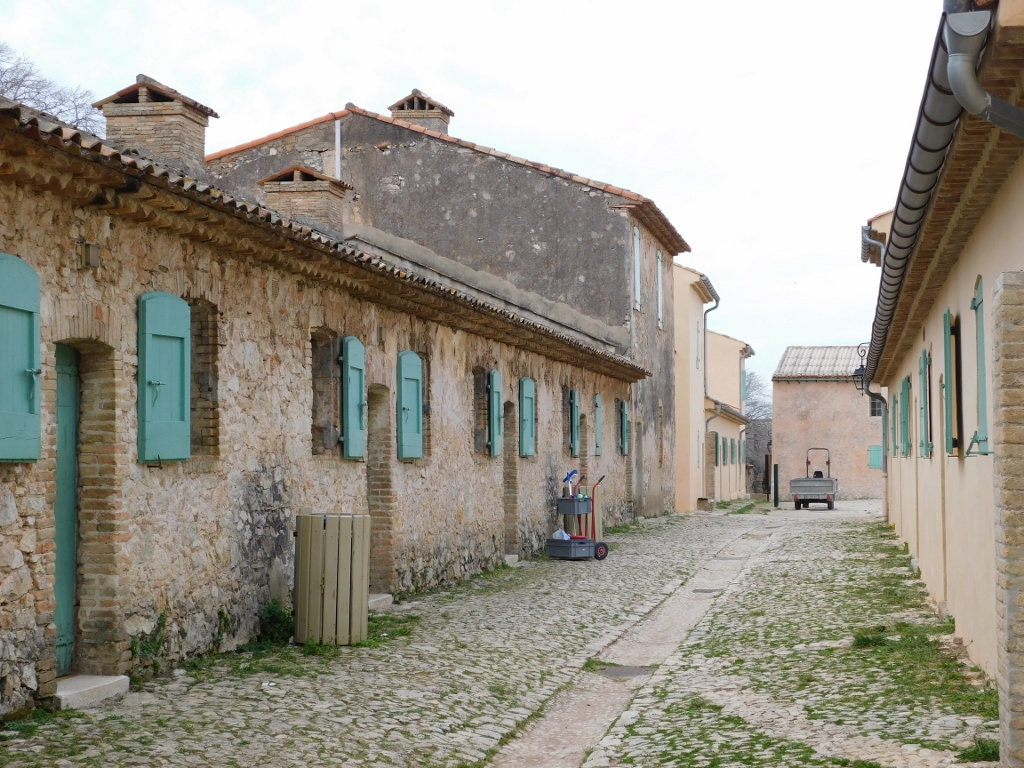 Fort Royal, a detail
Fort Royal, a detail
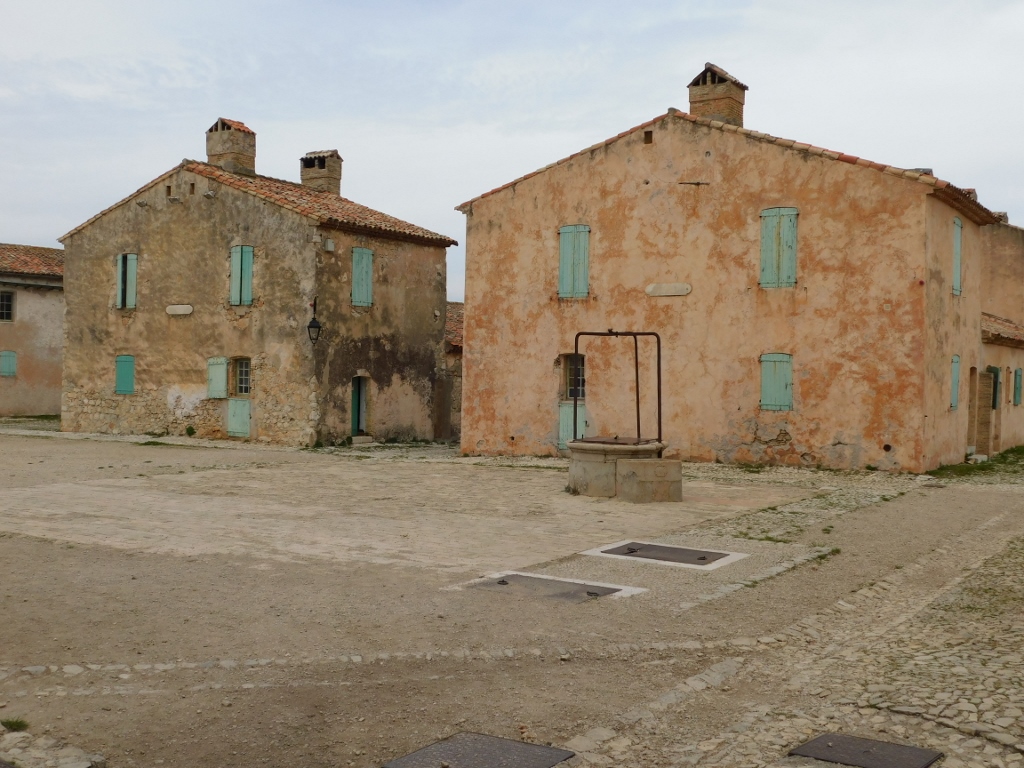 Fort Royal, a detail
Fort Royal, a detail
And so I went to a chapel from the 17th century.
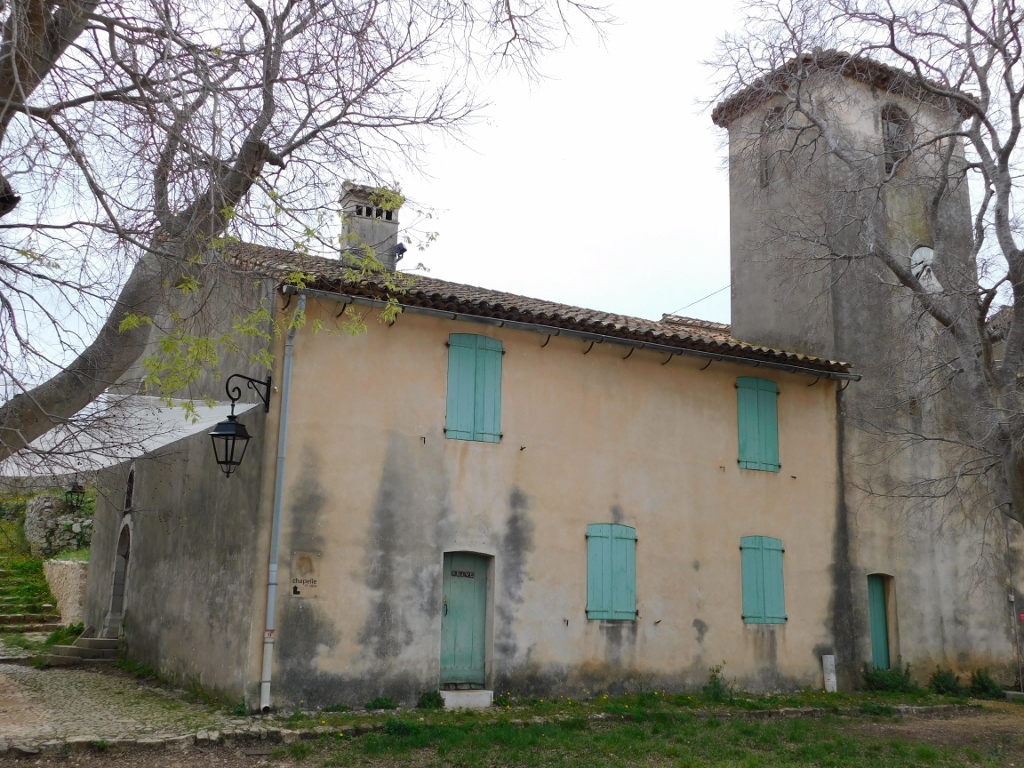 Fort Royal, the chapel
Fort Royal, the chapel
The door was open and I could get in, but the access to the naos was prevented by a metal fence.
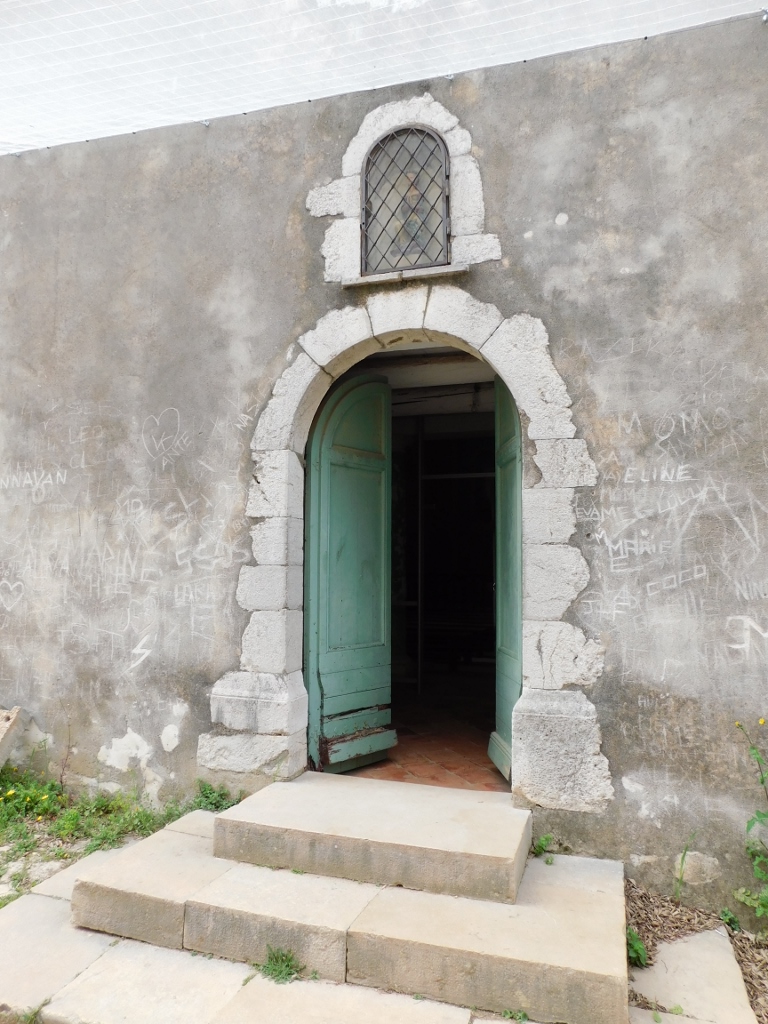 Fort Royal, entrance into the chapel
Fort Royal, entrance into the chapel
Still, it was possible to climb up to the first floor from where there was a nice view at the naos and the altar area.
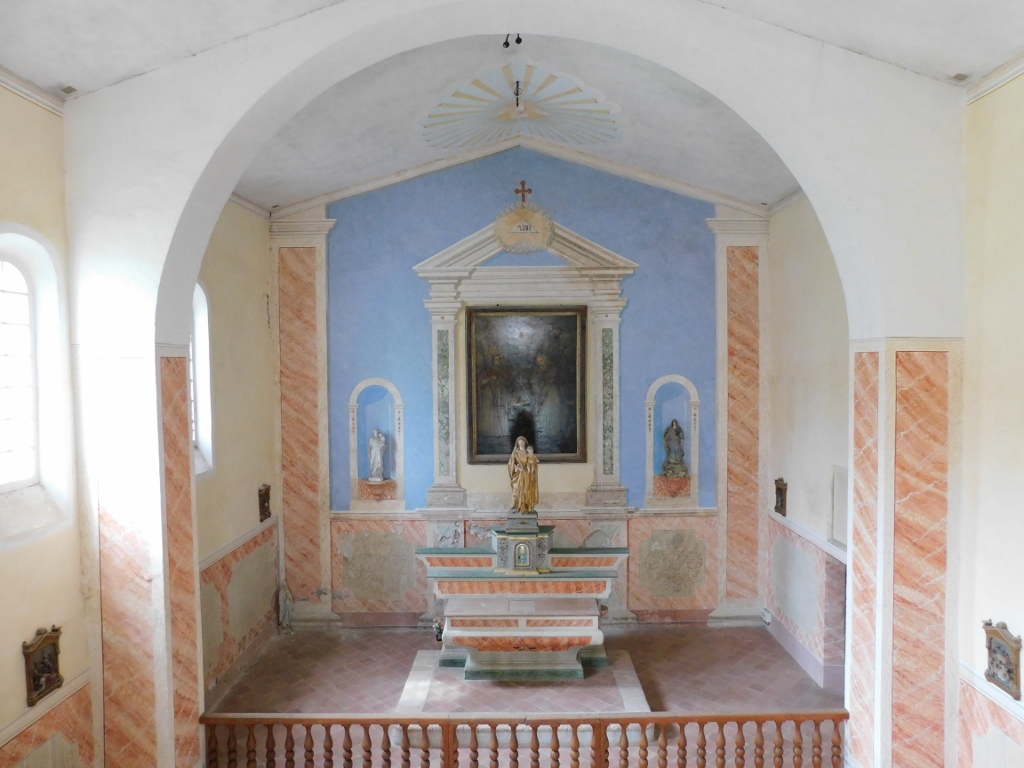 Fort Royal, the interior of the chapel
Fort Royal, the interior of the chapel
Not far from the chapel there is also an old magazine and I went there briefly, but it was closed.
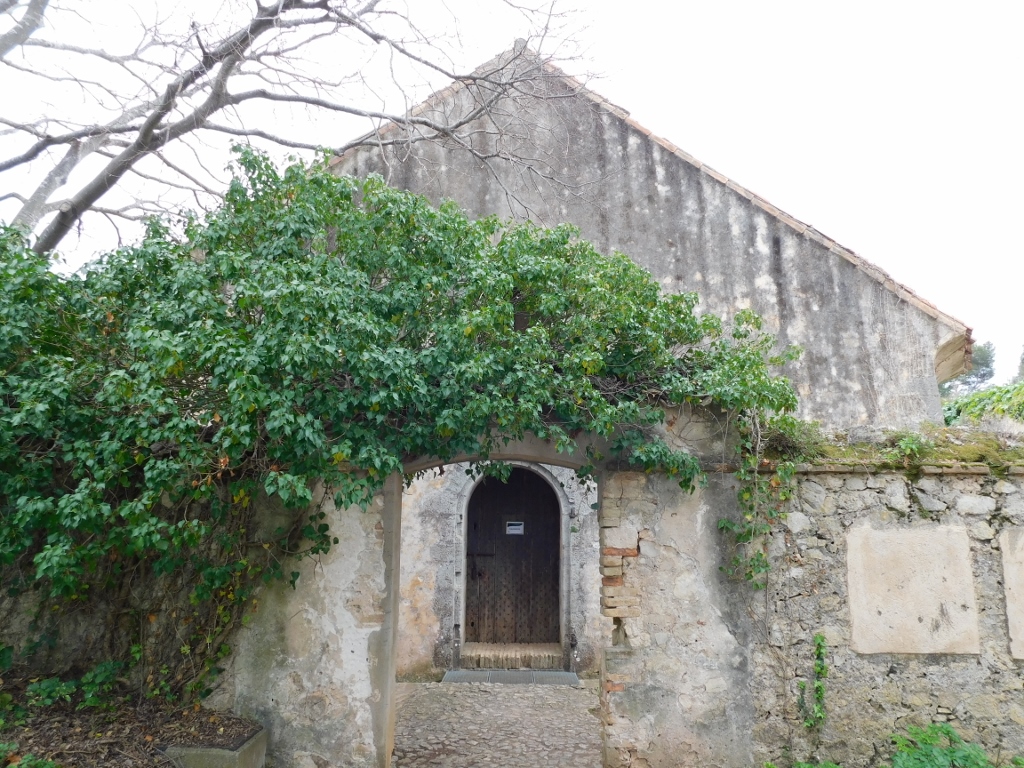 Fort Royal, the old magazine
Fort Royal, the old magazine
Here I practically finished with my visit to Fort Royal and I only made a few more photos before leaving the fortress. Here is one:
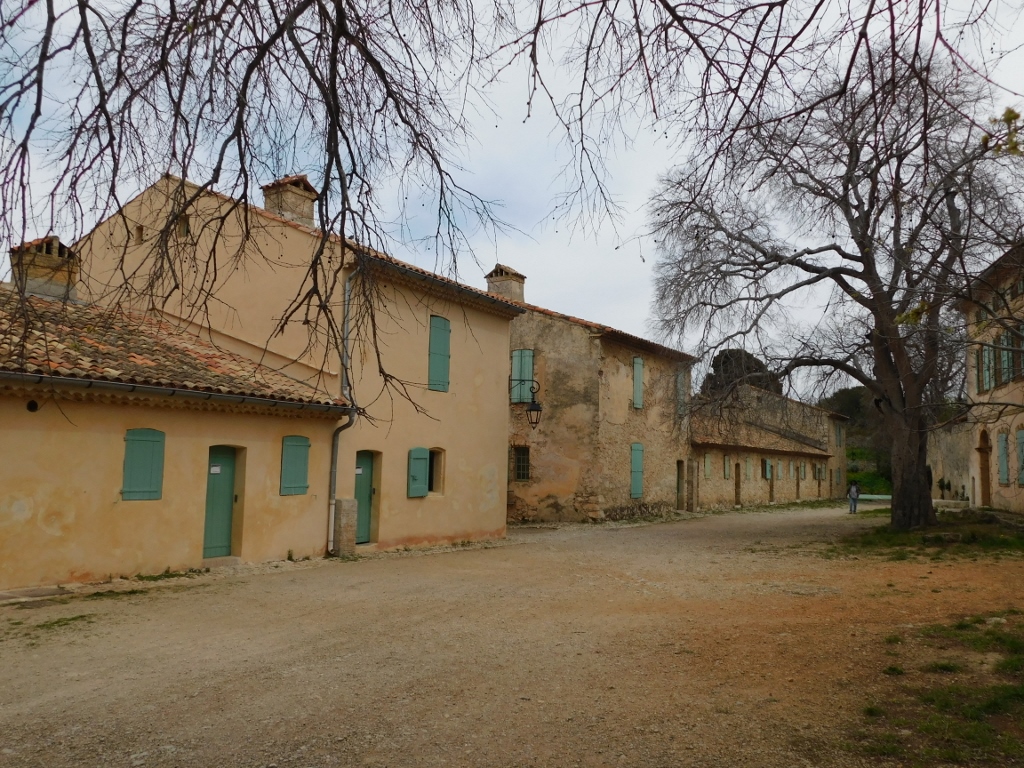 Fort Royal
Fort Royal
When I left the fortress I went for a walk following a wide path that runs around the fortress, but soon I realised this was not the direction in which I wanted to go, plus I had to be vigilant about my limited time and my return to Cannes.
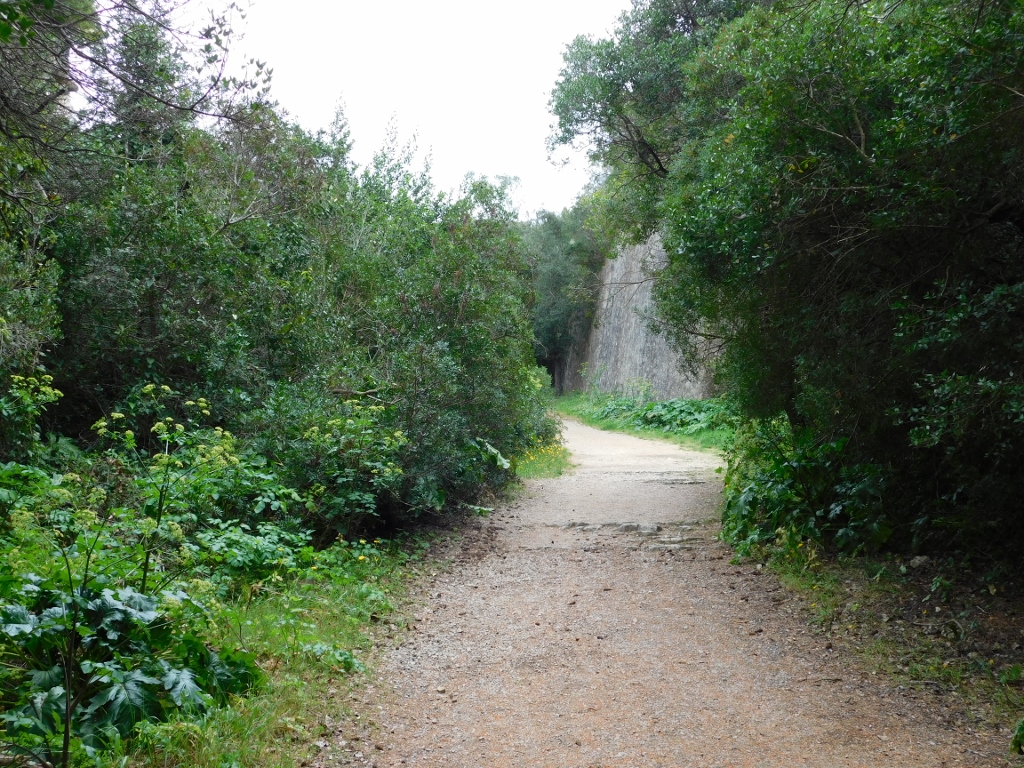 Path around Fort Royal
Path around Fort Royal
Very soon I reached one of the main paths and the walk was most pleasurable.
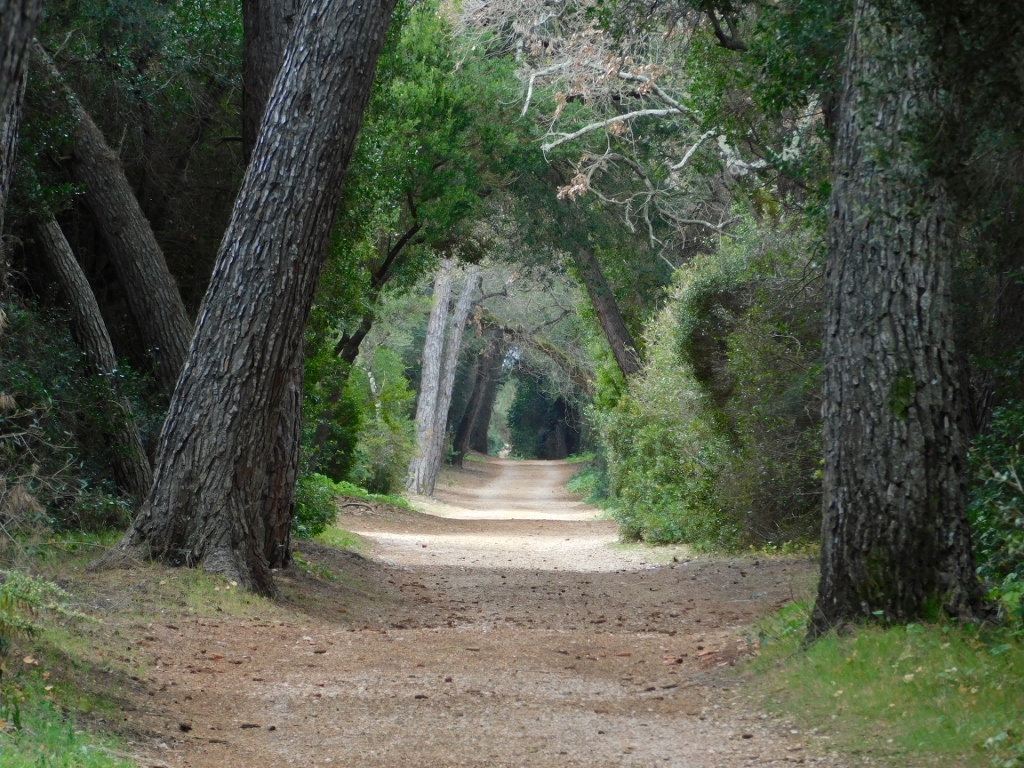 Path on Sainte-Marguerite Island
Path on Sainte-Marguerite Island
There are numerous wide paths like this on the island and one can spend several hours roaming here. I did not have that long, so I went towards the Dragon Point (Pointe du Dragon) following the most direct route.
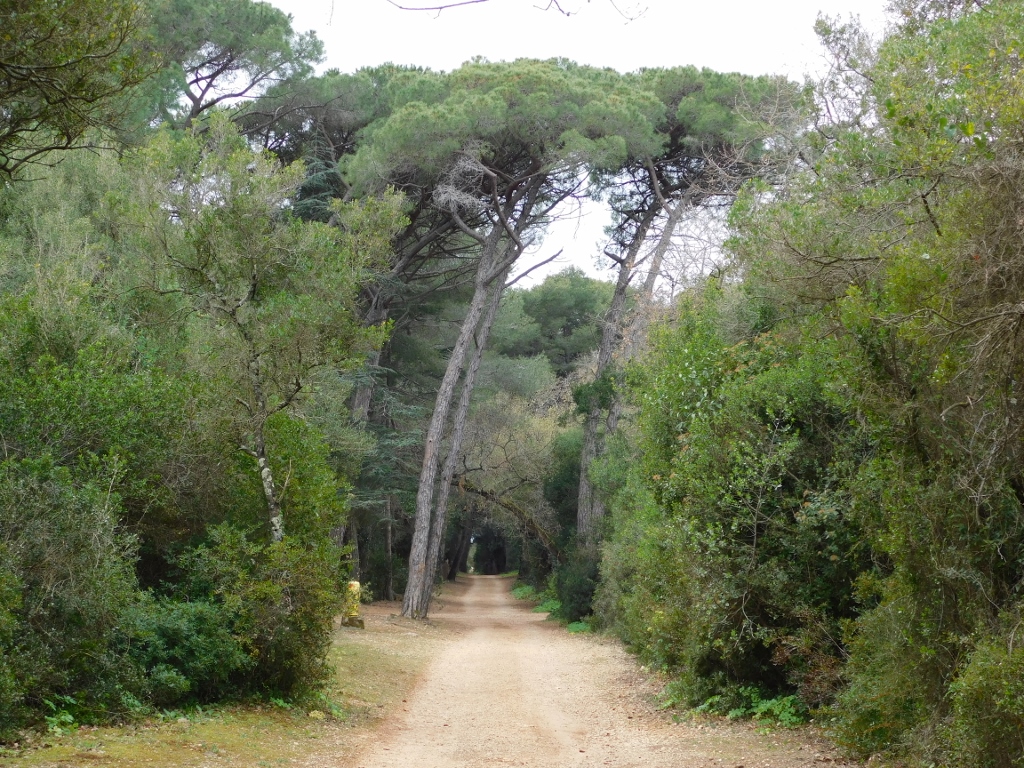 Path on Sainte-Marguerite Island
Path on Sainte-Marguerite Island
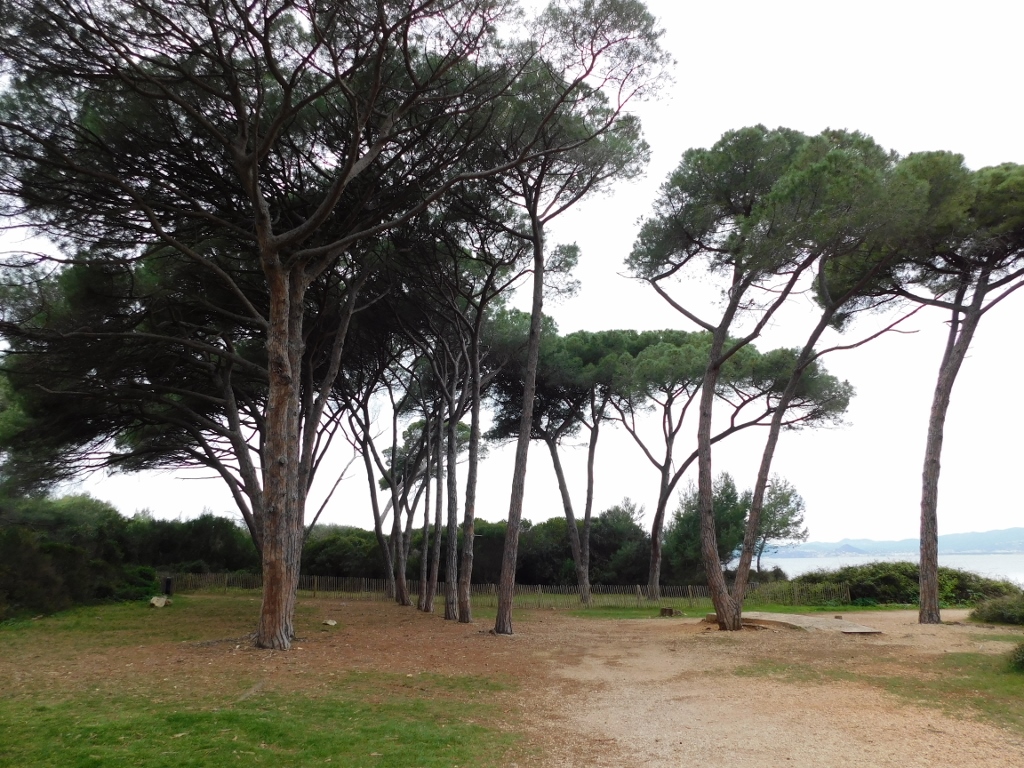 By the Dragon Point
By the Dragon Point
This promontory also contains a fine viewpoint, Belvédère du Dragon, where there is a platform rendering a nice view all around. Among other things, one can see well the neighbouring island, Île Saint-Honorat, that is also inhabited. This is the second largest among the Lérins Islands and it is around 1.5 km long and around 400 m wide.
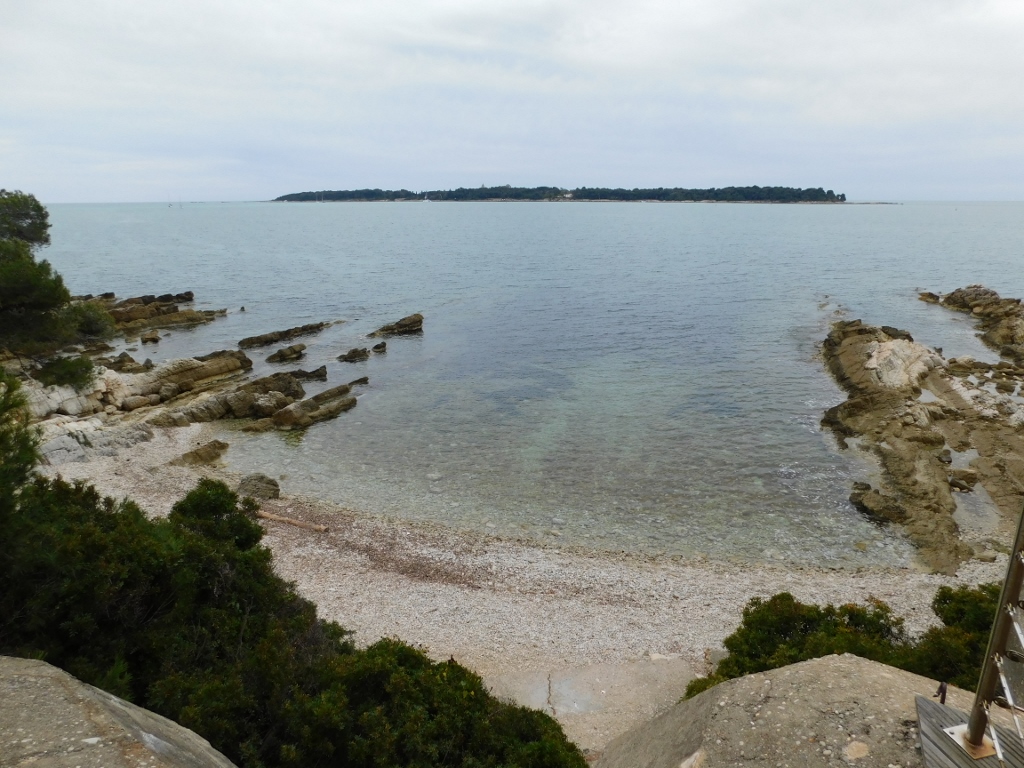 Saint-Honorat Island
Saint-Honorat Island
I have already mentioned before that a monastic community was founded on this island already in the 5th century, but this did not prevent the tiny island going through its fair share of turbulent times. Finally, in 1859, after a break of around 70 years, a monastic community was founded again here and it has been functioning ever since. Nowadays, there is a regular boat link from Cannes throughout the entire year, since the older parts of the monastery are open to visits, while the contemporary monastery is of a closed type. Still, there is also a monastery shop where, among other things, one can buy wine and olive oil produced on the island itself.
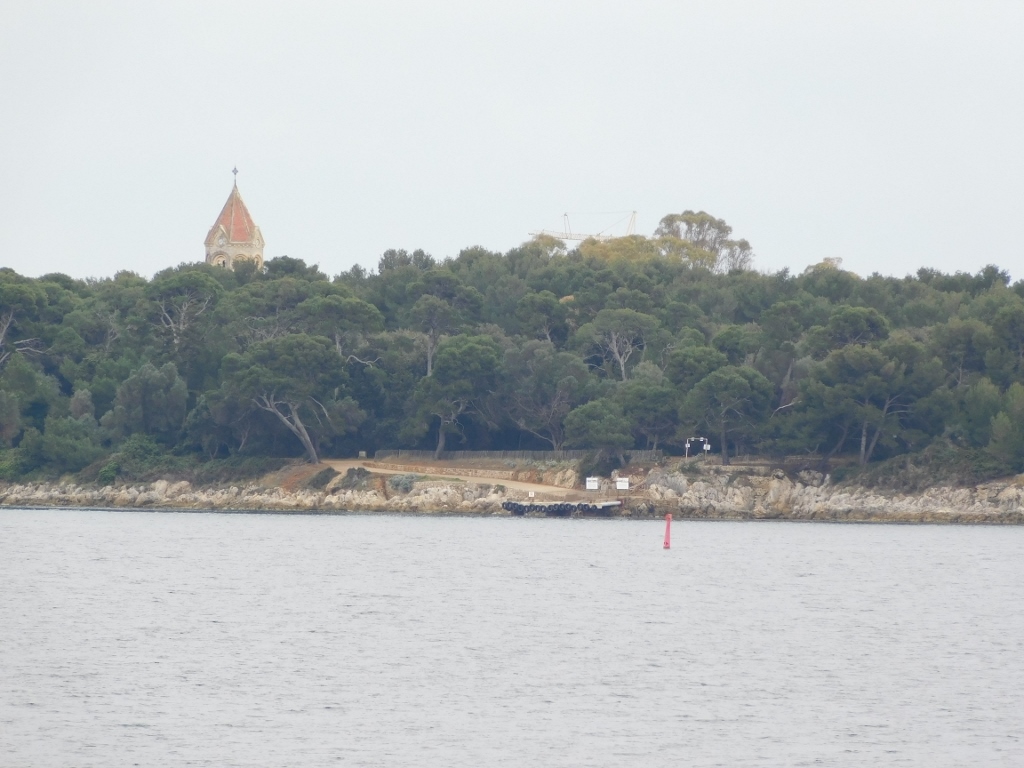 Saint-Honorat Island, a detail
Saint-Honorat Island, a detail
From the viewpoint at the Dragon Point, I continued with my walk along the shore enjoying the sights, as well as the company of some local residents.
 Beach on Sainte-Marguerite Island
Beach on Sainte-Marguerite Island
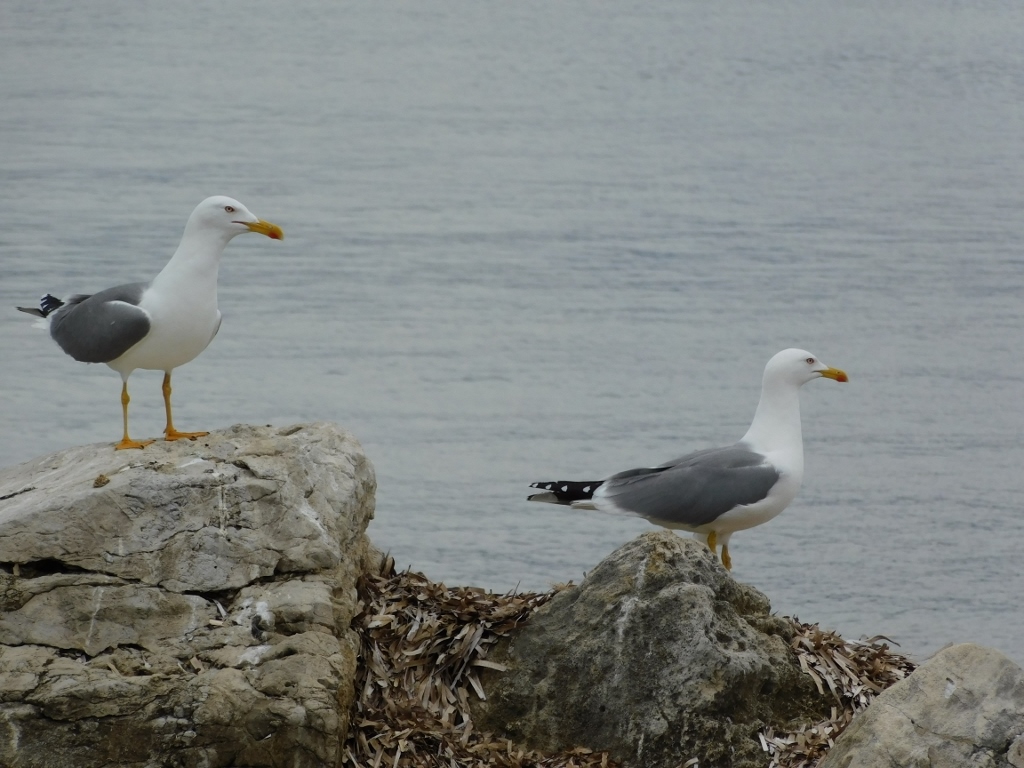 Seagulls on Sainte-Marguerite Island
Seagulls on Sainte-Marguerite Island
But, now I had to hurry, since the departure time of the boat I was to leave the island by was getting nearer. That’s why I followed a shortcut that leads by a pond that exists on the island, Étang du Batéguier.
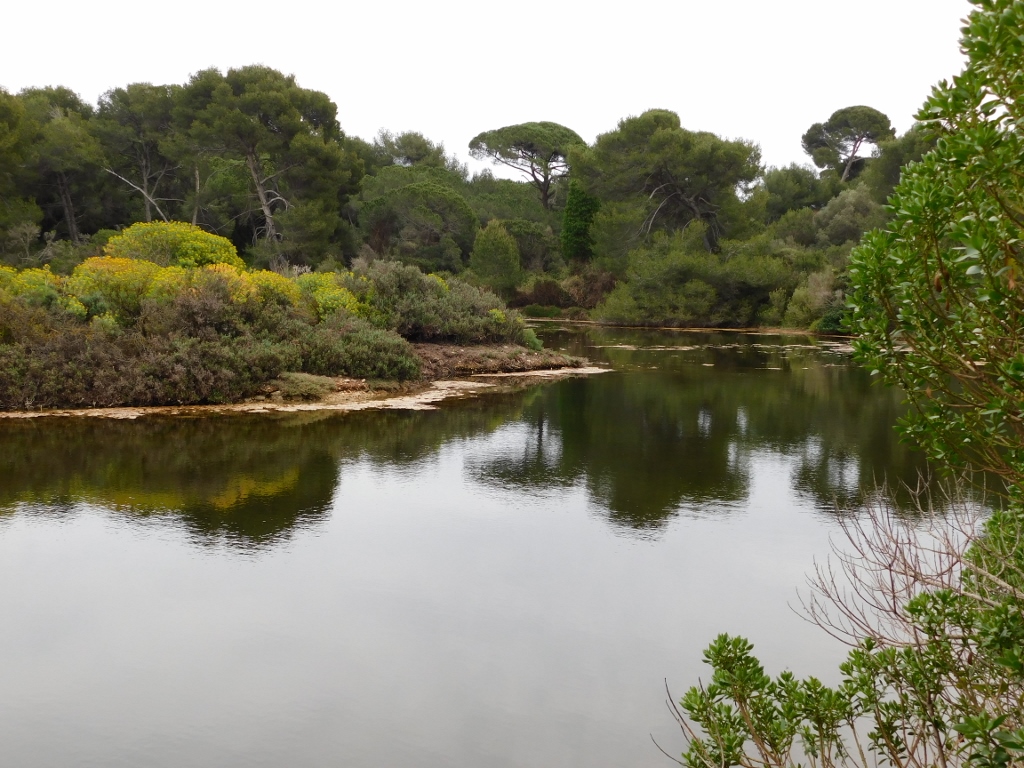 Étang du Batéguier
Étang du Batéguier
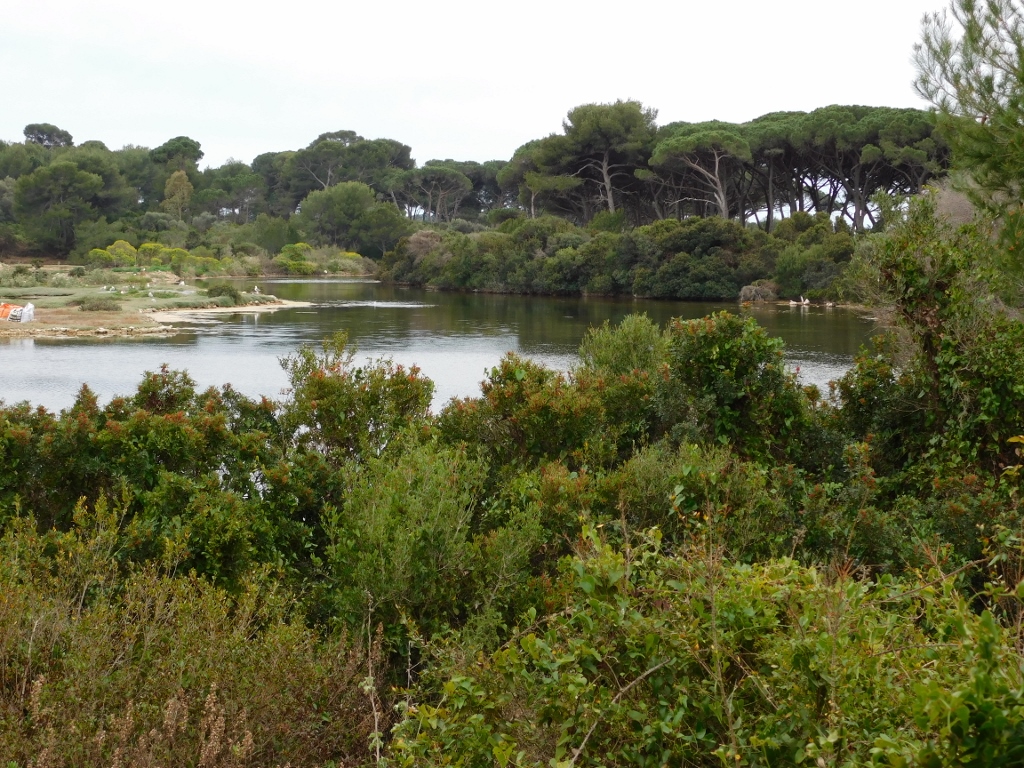 Étang du Batéguier
Étang du Batéguier
Numerous birds come to the pond, such was terns, gulls and gray herons, although I could only see the gulls. Anyway, I did not have the time to hang out there and watch the birds.
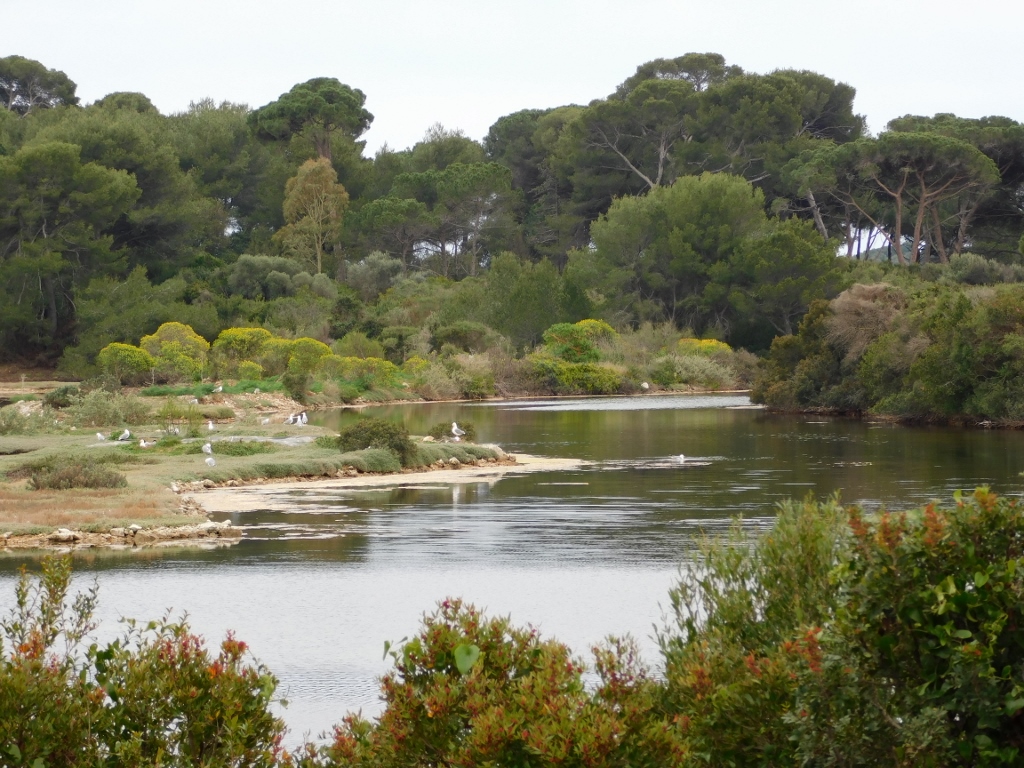 Étang du Batéguier
Étang du Batéguier
When I returned to the pier I could already notice the boat from the direction of Cannes that was getting closer to the island and soon after I boarded. In the meantime, I took a note of an elderly lady who was quietly fishing at the end of the wooden pier.
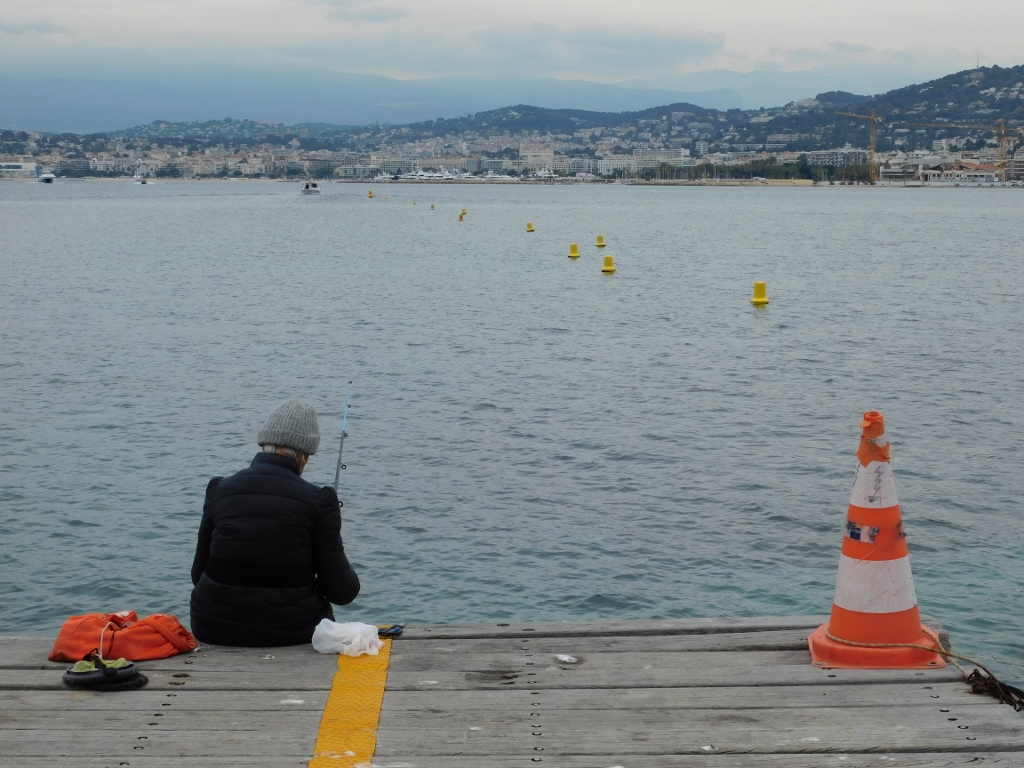 Sainte-Marguerite Island, a detail
Sainte-Marguerite Island, a detail
Having returned to Cannes, I headed for the Croisette, i.e., the promenade by the beach. When I left the port, first I walked past the Palace of Festivals and Conferences (Palais des Festivals et des Congrès) which is every year the venue of the Cannes Film Festival. At the time of my visit to the French Riviera, there was an international series festival here which for its guests uses pink carpet instead of a red one.
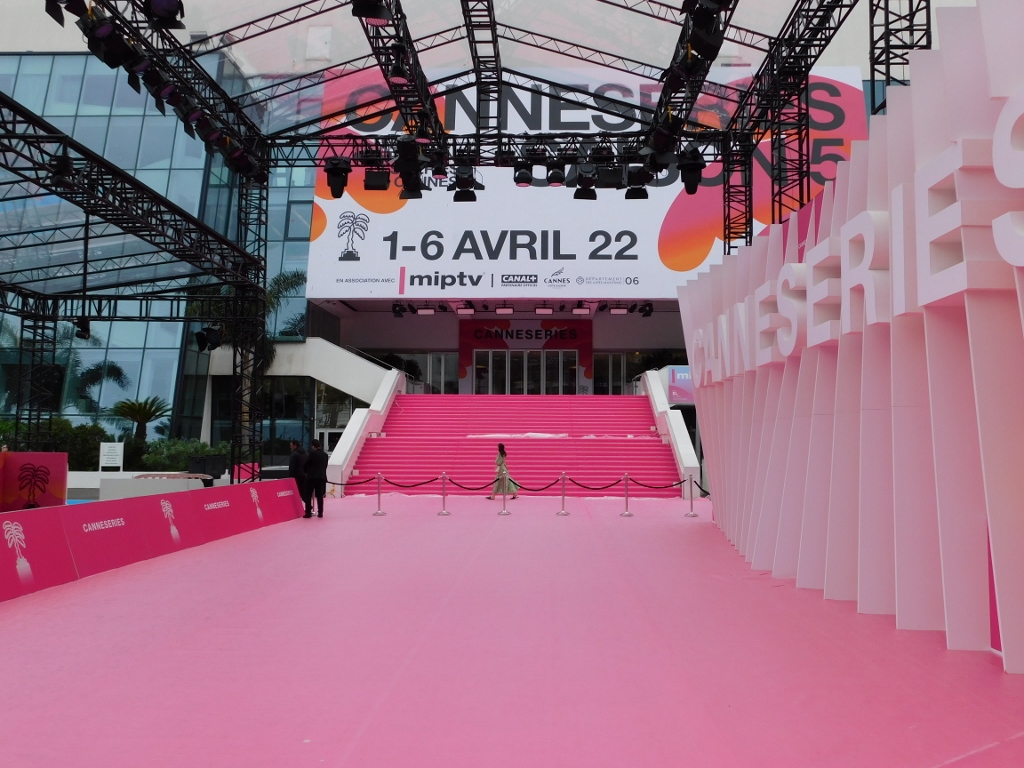 Pink carpet at the festival
Pink carpet at the festival
I passed by the flanks of the whole installation and there I noticed the end of the pink carpet. It occurred to me I could step on it and see what this was all about and why everybody is so overwhelmed by such type of experience. Apart from the fact that with its colour the pink carpet matched some details on my sneakers, nothing of importance happened and I did not feel any different than when walking over asphalt.
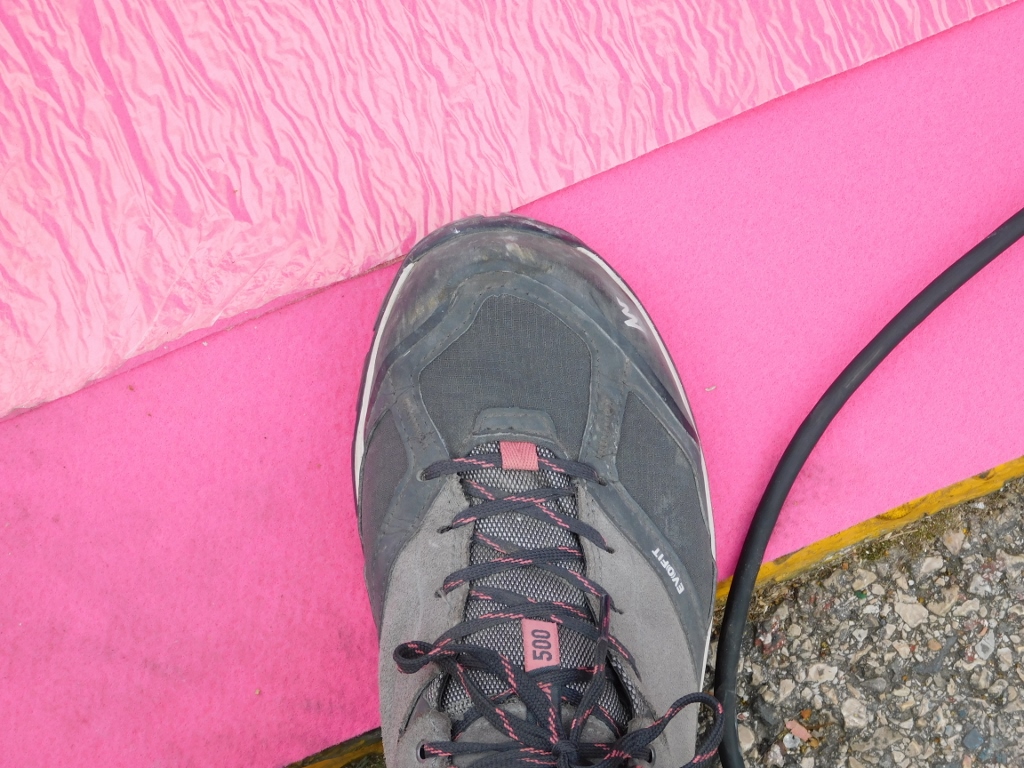 Me on the pink carpet
Me on the pink carpet
After the Palace of Festivals and Conferences, the Boulevard or the Promenade de la Croisette, or just Croisette, leads further first by a smallish park and then by the beach in Cannes.
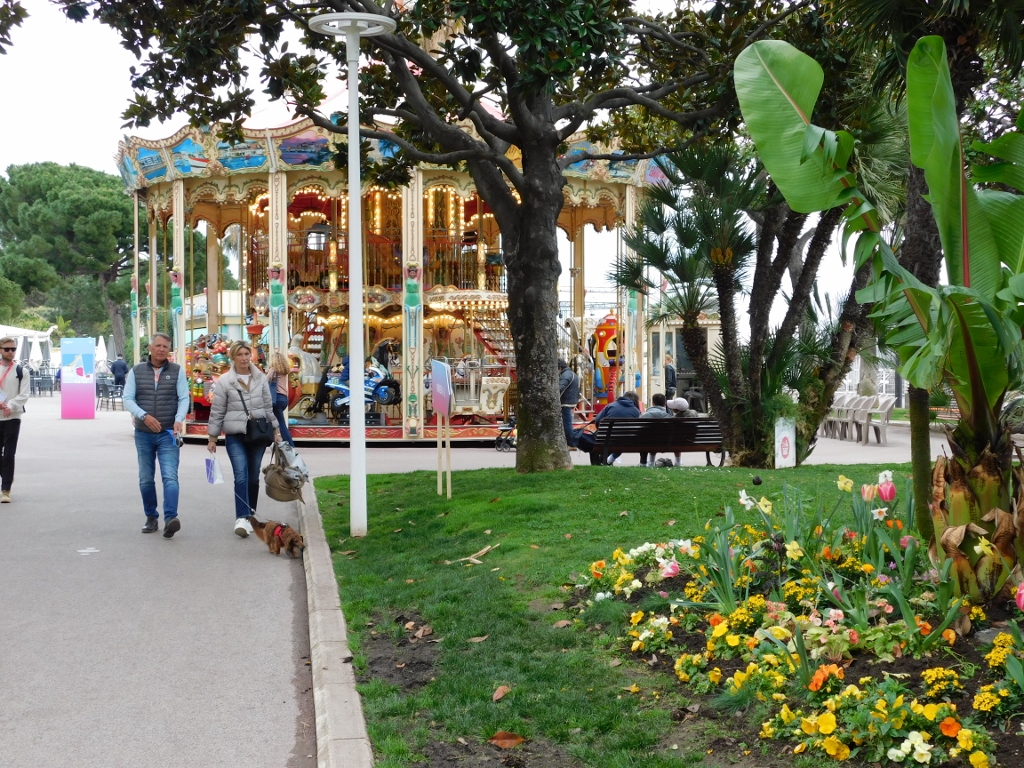 The Croisette promenade, a detail
The Croisette promenade, a detail
 Beach in Cannes
Beach in Cannes
By the way, one of the wide streets that from the Croisette leads directly towards the train station is the Street of the Serbs (Rue des Serbes). For me, this was worth noting.
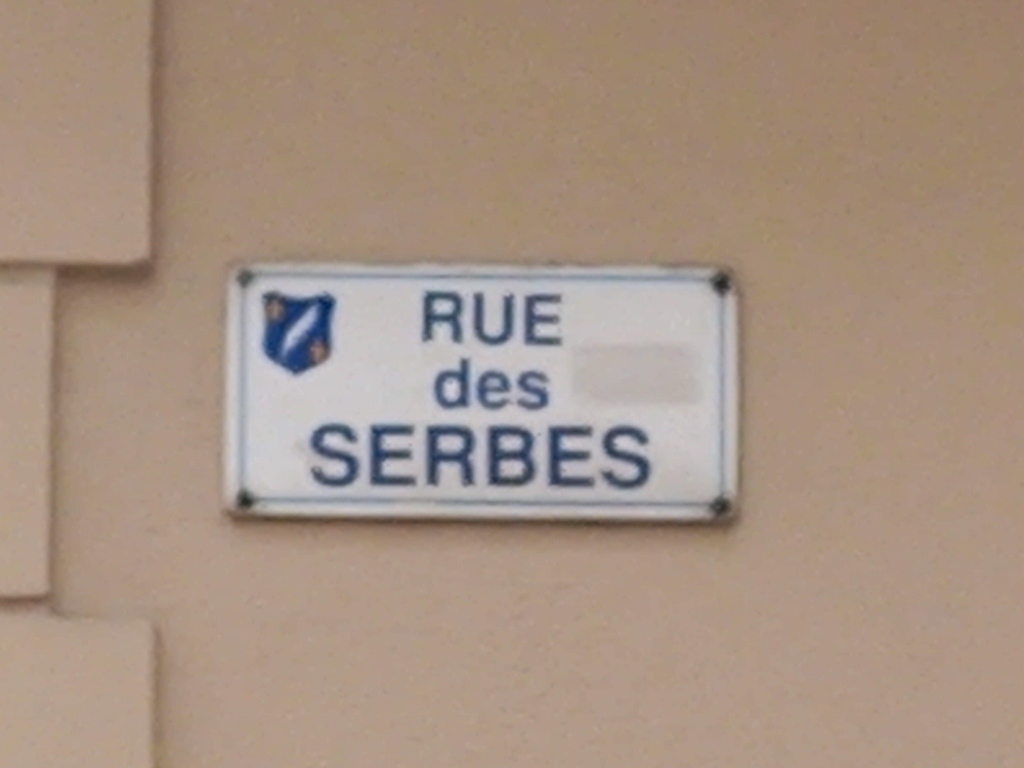 Street of the Serbs in Cannes
Street of the Serbs in Cannes
As for the beach, at the beginning of April it was far too cold for any swimmers, but many exclusive hotels and restaurants have their sections of the beach where it is possible to have a meal, as well as to lie down, irrespective of the weather. At least in theory. On this day, however, it was just too cold and cloudy, and most of the chairs and sunbeds were vacant waiting to be taken.
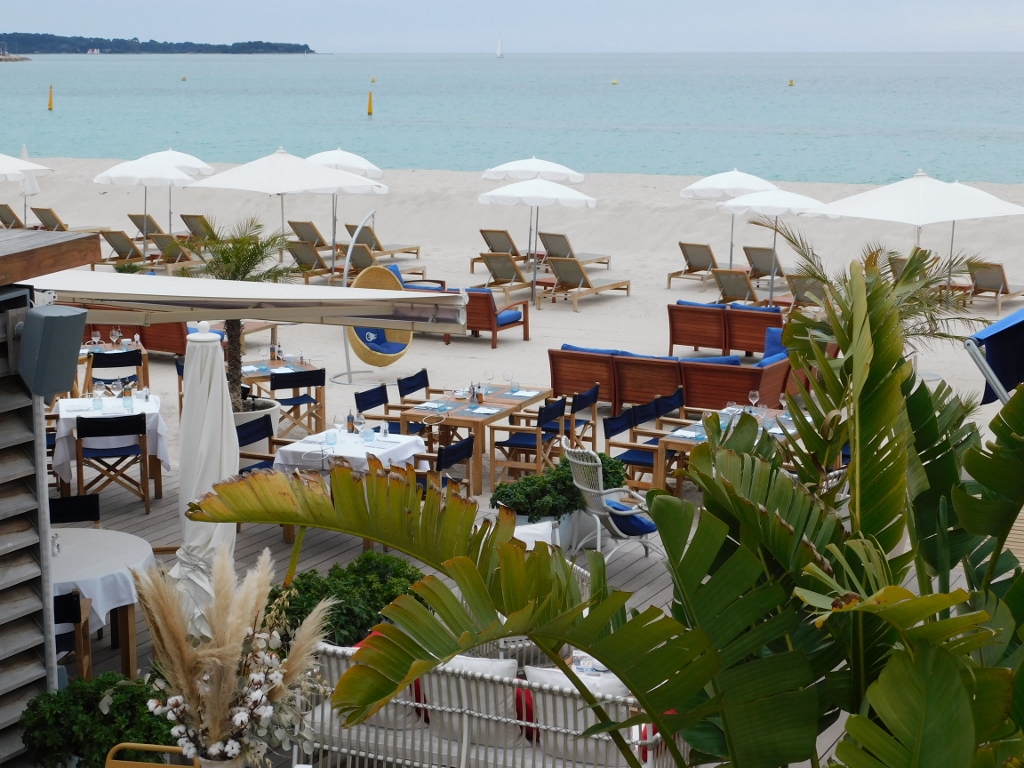 Beach in Cannes, a detail
Beach in Cannes, a detail
From the promenade I looked again at the port and the Old Town. I liked the sight.
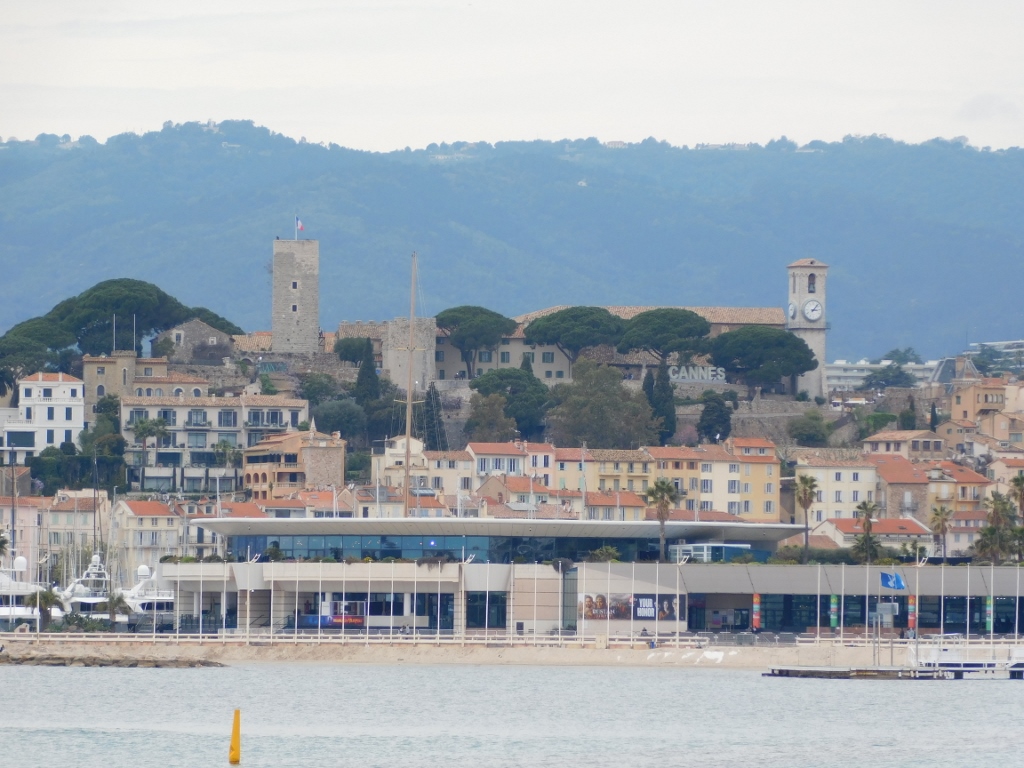 Le Suquet hillock
Le Suquet hillock
After a shorter walk by the sea in Cannes, I headed back to train station, for I wanted to go for a special walk. Namely, a short time before this trip, I watched on TV a programme about a pedestrian path by the coast, specifically on a promontory that belongs to Antibes, Cap d’Antibes. What makes this trail interesting is that it was set up in the part of the promontory where there are only a few private properties, but what private properties these are! One of them is an estate with a castle that was back in the day occupied by the Duke of Windsor and his wife (before marrying him she was known as Wallis Simpson). Later, the castle and the estate were owned for some years by Aristotle Onassis and in 2001 these were bought by Roman Abramovich. It is interesting that in April 2022, the French Government seized the castle and the estate from Abramovich as a part of the sanctions against Russian oligarchs.
And yet, I was not interested in the castle at all, but rather wanted to get to this littoral pedestrian path. In this programme that I saw on a French TV channel, the authors commented that in the past the owners of these few large estates had a direct access to the shore, this was practically their own private coast, but in the meantime the authorities made a decision that the littoral should belong to everybody and thus the pedestrian path was made there.
When I planned this mini-excursion, I looked at the map and at the time it seemed that this would be quite a nice and pleasant walk by the sea. Oh, how wrong I was! But, this is something that I often do when going on trips – in my desire to see as much as possible and because I love to walk, I simply overdo it.
And so, I took a train from Cannes to Antibes where I first started to walk around the town itself.